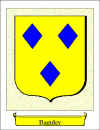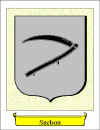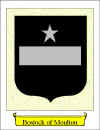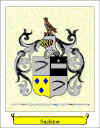Caroline Pamilla Bax
F, #2230, Deceased, b. 1845, d. 1917
Interactive Pedigree Button
Main Events
| Marriage | Caroline Pamilla Bax and James Pike were married. |
| User Reference Number | She; 23966 |
| Birth | She was born in 1845 was born <()> <()>. |
| Her daughter Charlotte Sarah Pike was born on 8 June 1875 in Grahamstown, South Africa. |
| Her husband James Pike died in 1897. |
| Death | Caroline Pamilla Bax died in 1917, at age ~72. |
Kenneth I Macalpin1,2
M, #2238, Deceased, b. about 810, d. 6 February 860
Interactive Pedigree Button
Parents
Main Events
| Residence | Kenneth I Macalpin resided Cináed mac AilpÃn (after 800–13 February 858), (anglicised Kenneth MacAlpin) was king of the Picts and, according to national myth, first king of Scots. Cináed's undisputed legacy was to produce a dynasty of rulers who claimed descent from him. If he cannot be regarded as the father of Scotland, he was the founder of the dynasty which ruled that country for much of the medieval period. His origins are clouded by myth and legend and are not definitively known.
Compared with the many questions on his origins, Cináed's ascent to power and subsequent reign can be dealt with simply. Cináed's rise can be placed in the context of the recent end of the previous dynasty, which had dominated Fortriu for two or four generations. This followed the death of king Eógan son of Óengus of Fortriu, his brother Bran, Ãed mac Boanta 'and others almost innumerable' in battle against the Vikings in 839. The resulting succession crisis seems, if the Pictish Chronicle king-lists have any validity, to have resulted in at least four would-be kings warring for supreme power.
Cináed's reign is dated from 843, it was probably not until 848 that he defeated the last of his rivals for power. The Pictish Chronicle claims that he was king in Dál Riata for two years before becoming Pictish king in 843, but this is not generally accepted. In 849, Cináed had relics of Columba, which may have included the Monymusk Reliquary, transferred from Iona to Dunkeld. Other that these bare facts, the Chronicle of the Kings of Alba reports that he invaded Saxonia 6 times, captured Melrose and burnt Dunbar, and also that Vikings laid waste to Pictland, reaching far into the interior.
Cináed died from a tumour on 13 February, 858 at the palace of Cinnbelachoir, perhaps near Scone. The annals report the death as that of the 'king of the Picts', not the 'king of Alba'. The title 'king of Alba' is not used until the time of Cináed's grandsons, Donald II of Scotland and Constantine II of_Scotland.
Cináed left at least two sons, Constantine and Ãed, who were later kings, and and at least two daughters. One daughter married Run, king of Strathclyde. Cináed's daughter Máel Muire married two important Irish kings of the Uà Néill. As the wife and mother of kings, when Máel Muire died in 913, her death was reported by the Annals of Ulster, an unusual thing for the misogynistic chronicles of the age.1 |
| User Reference Number | He; 18703 |
| Birth | He was born about 810.1 |
| Marriage | Kenneth I Macalpin was married about 833.1 |
| His son Constantine I Unknown was born about 836 in Scotland. |
| Death | Kenneth I Macalpin died on 6 February 860, at age ~50.2,1 |
| His father Constantine I Unknown died in 876. |
Citations
- [S1016] According to Otto Hirzell
- [S1017] Ancestors of Henry II
Hedwiga Unknown1,2
F, #2247, Deceased, b. about 846, d. 24 December 903
Interactive Pedigree Button
Parents
Main Events
| Also Known As | Hedwiga Unknown was also known as Hedwiga Unknown. |
| Marriage | Hedwiga Unknown and Otto Unknown were married.2,1 |
| User Reference Number | She; 18578 |
| Birth | She was born about 846 in Saxony, Germany.1 |
| Her mother Ingeltrude Unknown died in 870. |
| Her son Henry I The Fowler Unknown was born in 876 in Germany. |
| Her father Henry Unknown died in 886. |
| Death | Hedwiga Unknown died on 24 December 903, at age ~57.1 |
| Her husband Otto Unknown died on 30 November 912. |
Citations
- [S1016] According to Otto Hirzell
- [S1017] Ancestors of Henry II
Alice Annie Head
F, #2248, Deceased, b. about 1878
| Consanguinity | Partner of Richard Edward Clothier (1st cousin 2 times removed of Adrian John Snelson) |
Interactive Pedigree Button
Parents
Main Events
| User Reference Number | Alice Annie Head; 23706 |
| Birth | She was born about 1878 in Burton-on-Trent, England. |
| Marriage | Alice Annie Head and Richard Edward Clothier were married on 16 August 1908 in St Saviour's, St George's Square, Pimlico. |
| Her daughter Mary Irene Clothier was born about 1910 in Brighton, Sussex. |
| Her husband Richard Edward Clothier died on 1 June 1957 in Lewes, East Sussex, England. |
Census
| Label and Year | Manual |
|---|
| Census 1911 | Alice Annie Head Id #2,248 (Principal) was at home on Census night 1911 at Brighton, Brighton, Sussex; Address: 16 Tillstone St
Principal Role
Witness Role: wife
Original Documents, Source and Citations here |



